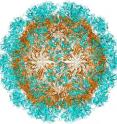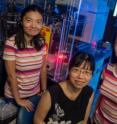Worm virus details come to light
Related images
(click to enlarge)
Rice University scientists have won a race to find the crystal structure of the first virus known to infect the most abundant animal on Earth. The Rice labs of structural biologist Yizhi Jane Tao and geneticist Weiwei Zhong, with help from researchers at Baylor College of Medicine and Washington University, analyzed the Orsay virus that naturally infects a certain type of nematode, the worms that make up 80 percent of the living animal population.
The research reported today in the Proceedings of the National Academy of Sciences will help scientists study how viruses interact with their nematode hosts. It may also allow them to customize the virus to attack parasitic or pathogenic worms. The research may also lead to new information about how viruses attack other species, including humans, which have thousands of genes that are identical to those found in nematodes.
Tao's lab specializes in X-ray crystallography, through which scientists determine the atom-by-atom structures of viruses, proteins and other macromolecules. Once a virus' structure is identified, biologists can look for binding sites that allow the virus to attach to its target. Scientists can then search for ways to modify the sites through genetic engineering or design drugs to block viruses.
Zhong, who studies gene networks in Caenorhabditis elegans to trace signal pathways common to all animals, said she'd been looking for this opportunity for some time. "We had talked before 2011 about the fact that there were no known viruses that affect nematodes," Tao confirmed. "Then in 2011, there it was."
Zhong then asked Marie-Anne Félix and co-author David Wang, who discovered the infected worm in an apple orchard in France, for a sample of the virus. At that time, the Rice researchers learned others were also working to find the structure.
Tao's lab began by synthesizing the Orsay capsid protein and then coaxed the proteins to self-assemble into structures that were identical to the full virus. A comparison of these structures with electron microscope images of the actual virus confirmed their success.
"We got the crystals in May after three months of molecular cloning, expression and purification of the proteins," said lead author Yusong Guo, a graduate student co-mentored by Tao and Zhong. "Then we spent about a year-and-a-half to actually solve the structure as fast and accurately as possible, knowing that other groups were competing with us."
Their efforts led to a detailed structural model of the viral capsid, the hard, spiky shell that protects the infectious contents as the virus searches for and then attaches to a host cell.
Guo's structure showed the Orsay capsid consists of 180 copies of the capsid protein, each contributing to one of 60 spikes that adorn the shell. Tao said the capsid structure revealed surprising similarity to a group of fish-infecting viruses called nodaviruses. The researchers also observed similarities in the part of the protein that forms the spikes to the hepatitis E virus and calicivirus, suggesting possible evolutionary relationships between them.
They also found they could destabilize the virus by modifying one end -- the N-terminal arm -- of the capsid protein.
Zhong said the virus doesn't kill its host, but causes intestinal distress. "That's actually a sign that these two species (the worm and the virus) have been coevolving for a long time, because if a virus kills its host, they're not going to coexist for long," she said. "The worm and the virus thus make a good model system to study host-virus interactions."
The capsid spike structure is important, Tao said, because "it likely interacts with the host cell receptors. Now that we know this domain, we can specifically change it so that maybe, instead of targeting this worm, it will target a different species of worm."
Two other viruses have since been found to infect a different strain of nematode, but there's satisfaction in being the first to detail the first such virus discovered.
"There are 20,000 genes in C. elegans, and 8,000 of them are conserved between humans and worms," Zhong said. "How many of those genes are involved in antiviral defense? We can study that now."
Source: Rice University
Other sources
- Worm virus details come to lightfrom Science DailyTue, 19 Aug 2014, 14:00:59 UTC
- Scientists win race to find structure of rare nematode virusfrom PhysorgMon, 18 Aug 2014, 19:20:24 UTC


